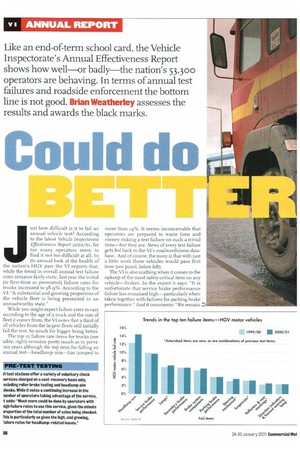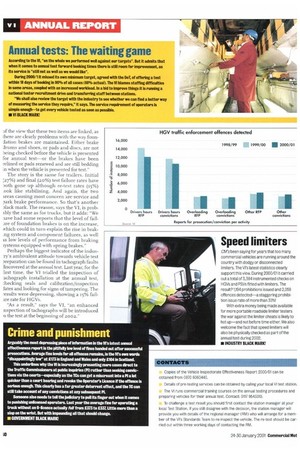Could do
Page 38

Page 40

If you've noticed an error in this article please click here to report it so we can fix it.
Like an end-of-term school card, the Vehicle Inspectorate's Annual Effectiveness Report shows how well—or badly—tae nation's 53,300 operators are behaving. In terms of annual test failures and roadside enforcement the bottom line is not good. Brian Weatherley assesses the results and awards the black marks.
Just how difficult is it to fail an annual vehicle test? According to the latest Vehicle Inspectorate Effectiveness Report z000lot, far too many operators seem to find it not too difficult at all. In its annual look at the health of the nation's H GV parc the VI reports that, while the trend in overall annual test failure rates remains fairly static, last year the initial (ie first-time as presented) failure rates for trucks increased to 38.9%. According to the VI: "A substantial and growing proportion of the vehicle fleet is being presented in an unroadworthy state."
While you might expect Failure rates to vary according to the age of a truck and the size of fleet it comes from, the VI notes that a third of all vehicles from the largest fleets still initially Fail the test. So much for bigger being better.
The top io failure rate items for trucks (see table, right) remains pretty much as in previDUS years although the top item for failing an annual test headlamp aim—has jumped to
more than 14%. It seems inconceivable that operators are prepared to waste time and money risking a test failure on such a trivial item—but they are. News of every test failure gets fed back to the VI's roadworthiness database. And of course, the irony is that with just a little work these vehicles would pass first time (see panel, below left).
The VI is also scathing when it comes to the upkeep of the most safety-critical item on any vehicle—brakes. In the report it says: It is unfortunate that service brake performance failure has remained high—particularly when taken together with failures for parking brake performance." And it comments: "We remain of the view that these two items are linked, as there are clearly problems with the way foun:lation brakes are maintained. Either brake drums and shoes, or pads and discs, are not being checked before the vehicle is presented for annual test—or the brakes have been relined or pads renewed and are still bedding in when the vehicle is presented for test."
The story is the same for trailers. Initial l27%) and final (.2.0%) test failure rates have 3oth gone up although re-test rates (15%) .00k like stabilising. And again, the two ireas causing most concern are service and oark brake performance. So that's another 'lack mark. The reason, says the VI, is prob. ibly the same as for trucks, but it adds: "We :lave had some reports that the level of failare of foundation brakes is on the increase, xhich could in turn explain the rise in brak.ng system and component failures, as well is low levels of performance from braking 3ystems equipped with spring brakes."
Perhaps the biggest indicator of the indus:ry's ambivalent attitude towards vehicle test 3reparation can be found in tachograph faults iiscovered at the annual test. Last year, for the irst time, the VI trialled the inspection of :achograph installation at the annual test, :hecking seals and calibration/inspection iates and looking for signs of tampering. The :esults were depressing, showing a 15% failire rate for HGVs.
"As a result," says the VI, "an enhanced nspection of tachographs will be introduced o the test at the beginning of 2002."












































































































































